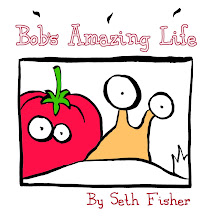
This page follows the one I posted yesterday: one of the really thrilling pages from this series.
As in most of his pages, the horizon line changes from panel to panel. The bottom panel, which takes up just a little less than half the page, is the climax of the page, and also of this issue. (The original readers had to wait until the following month to find out what would happen next.) Seth has pulled out all the stops for this picture. He makes use of 3-point perspective (Tip 10: Use 3-point perspective for more movement). The horizon line is at floor level, so Hike falls toward the viewer, and Maki's block of her brother's attack is going on above us. Under her feet we see Steve in the back furiously filming the action. Legs, arms, and torsos are all pointed in different directions, though all the action is very clearly visible. Because the horizon is so low and Seth has used 3-point perspective, the floor is the only thing in the picture that is actually horizontal. Even though the background--if we saw it live--would be full of horizontal and vertical lines, the picture has no 90 degree angles. This makes it utterly non-static, full of motion, though it is clean and crisp.
As in most of his pages, the horizon line changes from panel to panel. The bottom panel, which takes up just a little less than half the page, is the climax of the page, and also of this issue. (The original readers had to wait until the following month to find out what would happen next.) Seth has pulled out all the stops for this picture. He makes use of 3-point perspective (Tip 10: Use 3-point perspective for more movement). The horizon line is at floor level, so Hike falls toward the viewer, and Maki's block of her brother's attack is going on above us. Under her feet we see Steve in the back furiously filming the action. Legs, arms, and torsos are all pointed in different directions, though all the action is very clearly visible. Because the horizon is so low and Seth has used 3-point perspective, the floor is the only thing in the picture that is actually horizontal. Even though the background--if we saw it live--would be full of horizontal and vertical lines, the picture has no 90 degree angles. This makes it utterly non-static, full of motion, though it is clean and crisp.





4 comments:
Most of Seth’s projects have had the benefit of good colouring, more than likely due to Seth having a hand in most of them (at least as a guide), but I really wish companies would print up black and white versions also.
These Tokyo pages are dynamic in many, many ways.
I'm not sure how much of a hand Seth actually had in the coloring. He never was comfortable with his ability to use color well. (He was generally pleased with what the colorists did with his work.) But I suspect that his pages offered so much of a challenge to colorists, in the fact of having almost no black or grey areas, that they were challenged to put their out their best possible work.
However I agree with you that the black and white versions are different and worth seeing. In most cases I like Seth's work better in black and white.
Here’s what I can find quickly. I have another interview (maybe just printed up and at home) where he mentions ‘guiding’ (I think that was the word) the colourist a bit. Maybe it was on Happydale.
Fisher: "Man, coloring is really, really important for my stuff. Since I don't usually use blacks on my page, people always tell me it looks like a coloring book. The colorist makes or breaks my art. The trick is finding a style to color my work in that allows a colorist to do it and keep their sanity. Even coloring my own work is a pain in the arse. I didn't choose the colorists by name, but I sent samples of colored pages to my editors and told them the feel I wanted. Then they found people that could
match that. With Chuckery though, he just went way beyond what I was expecting. He is awesome."
Jay, your research is impressive. Yes, I remember how much he like Chris Chuckry's coloring. That was on Vertigo Pop, Willworld, AND Fantastic Four.
Maybe he DID guide the colorist on Happydale (and others). I do remember his talking about the colors there. He was pretty happy with how it came out; he wasn't sure what was going to happen, especially as he was so new to the whole business at that time.
Post a Comment